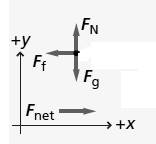
Concept explainers
The coefficient of kinetic friction between the two given surfaces.
Answer to Problem 22PP
The coefficient of kinetic friction between the given surfaces is
Explanation of Solution
Given:
A block of mass 1.4-kg slides along a rough surface and it slows down with a acceleration
Formula Used:
The distribution of forces on the block in shown in Figure 1.

Figure 1
Here, the block is moving freely with a deceleration and hence the net force acting on it is the kinetic frictional force. This can be expressed as
The net force is given by
Now, the kinetic friction force will be proportional to the normal force acting in the body. In this case, the normal force is equal to the weight of the body as there are no other forces along the normal.
Thus, the kinetic friction force can be expressed as,
Here
Based on this, netforce can be expressed as
And, the coefficient of kinetic friction can be calculated as,
Calculation:
From the equation for coefficient of kinetic friction, it can be observed that under free sliding, the coefficient of friction is independent of mass of the object and it depends on the acceleration values.
Now, by substituting the acceleration due to gravity and acceleration of the block, the coefficient of kinetic friction can be calculated based on (5) as
Conclusion:
Thus, the coefficient of kinetic friction between the given surfaces is 0.1275.
Chapter 5 Solutions
Glencoe Physics: Principles and Problems, Student Edition
Additional Science Textbook Solutions
Physics for Scientists and Engineers: A Strategic Approach with Modern Physics (4th Edition)
Tutorials in Introductory Physics
University Physics with Modern Physics (14th Edition)
Physics: Principles with Applications
Conceptual Physics (12th Edition)
College Physics: A Strategic Approach (3rd Edition)
 College PhysicsPhysicsISBN:9781305952300Author:Raymond A. Serway, Chris VuillePublisher:Cengage Learning
College PhysicsPhysicsISBN:9781305952300Author:Raymond A. Serway, Chris VuillePublisher:Cengage Learning University Physics (14th Edition)PhysicsISBN:9780133969290Author:Hugh D. Young, Roger A. FreedmanPublisher:PEARSON
University Physics (14th Edition)PhysicsISBN:9780133969290Author:Hugh D. Young, Roger A. FreedmanPublisher:PEARSON Introduction To Quantum MechanicsPhysicsISBN:9781107189638Author:Griffiths, David J., Schroeter, Darrell F.Publisher:Cambridge University Press
Introduction To Quantum MechanicsPhysicsISBN:9781107189638Author:Griffiths, David J., Schroeter, Darrell F.Publisher:Cambridge University Press Physics for Scientists and EngineersPhysicsISBN:9781337553278Author:Raymond A. Serway, John W. JewettPublisher:Cengage Learning
Physics for Scientists and EngineersPhysicsISBN:9781337553278Author:Raymond A. Serway, John W. JewettPublisher:Cengage Learning Lecture- Tutorials for Introductory AstronomyPhysicsISBN:9780321820464Author:Edward E. Prather, Tim P. Slater, Jeff P. Adams, Gina BrissendenPublisher:Addison-Wesley
Lecture- Tutorials for Introductory AstronomyPhysicsISBN:9780321820464Author:Edward E. Prather, Tim P. Slater, Jeff P. Adams, Gina BrissendenPublisher:Addison-Wesley College Physics: A Strategic Approach (4th Editio...PhysicsISBN:9780134609034Author:Randall D. Knight (Professor Emeritus), Brian Jones, Stuart FieldPublisher:PEARSON
College Physics: A Strategic Approach (4th Editio...PhysicsISBN:9780134609034Author:Randall D. Knight (Professor Emeritus), Brian Jones, Stuart FieldPublisher:PEARSON





